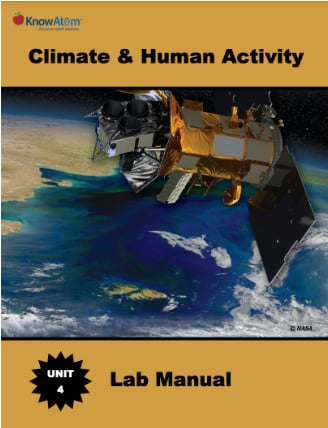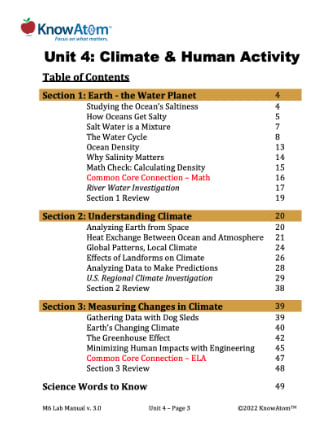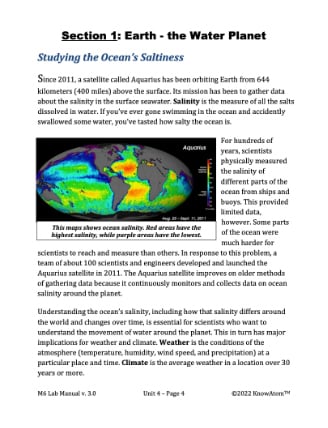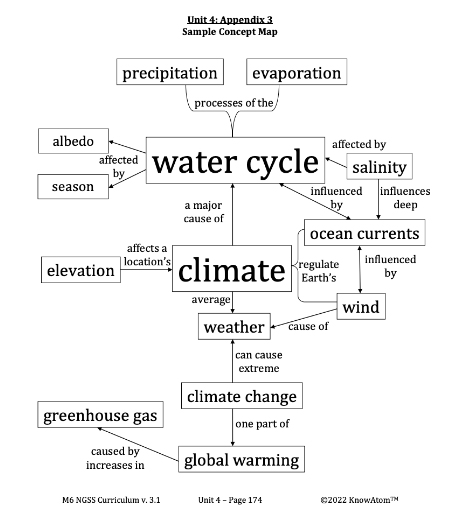In this lesson, students explore phenomena in Earth’s systems and the connection between the amount of thermal energy present and the concentration and state of water on Earth as it moves through a phenomena called the water cycle.
In this unit, students explore the science phenomena of matter, energy, and heat transfer to explore weather and climate. In this lesson they investigate how the sun powers the global water cycle, which in turn has very local impacts that affect regional climates around the world. This page is a high-level extract of this lesson.
Science background gives teachers more in-depth information on the phenomena students explore in this unit. Here is an excerpt from this section on the water cycle.
The water cycle is complex, and it varies in different parts of the world and at different times of year depending on the amount of thermal energy available. For example, very deep groundwater can take thousands of years to complete the water cycle and return to the ocean.
Similarly, most of the fresh water on Earth is stored in glaciers and ice caps, where it can remain frozen for thousands of years. The process of water freezing into solid ice is called crystallization. In contrast, in hot climates and seasons, precipitation sometimes evaporates just seconds after it falls to Earth’s surface.
These differences can be understood partly by Earth’s position and movement in the solar system relative to the sun. To begin, Earth is tilted 23.5 degrees. As a result of this tilt, the sun’s rays shine directly onto the planet around the equator. The sun’s rays are the most concentrated here, which causes temperatures to be high. This results in ocean water that is hot enough to quickly evaporate into water vapor and condense into large clouds.
Moving north or south of the equator, the sun’s rays are spread over a larger area, so each square meter of Earth’s surface receives less solar energy. As a result, these regions have lower temperatures, which results in more water being stored as ice for longer periods of time.
Earth’s movement around the sun also affects the water cycle because it determines seasonal changes. A season is a period of time characterized by specific weather patterns and by the length of day and night. Earth fully orbits the sun once every 365.25 days. For half of the year, the North Pole is tilted toward the sun. This results in summer in the north and winter in the south. For the other half of the year, Earth’s North Pole is tilted away from the sun. This results in winter in the north and summer in the south. The point when the North Pole is in between a full tilt toward or away from the sun creates the seasons of spring and fall.
Each season has similar patterns of weather in specific locations. In tropical and polar climates, the weather is relatively consistent throughout the year. Tropical climates are warm and humid throughout the year. Close to the equator, there are only two seasons: a wet season and a dry season. The wet season lasts most of the year and is called the wet season because of how much it rains.
Polar climates are cold throughout the year. Regions with polar climates cover 20 percent of the planet. Polar climates often result in few trees, with glaciers or a permanent or semi-permanent layer of ice.
In contrast, in temperate zones, the weather changes with the four seasons: fall, winter, spring, and summer. Temperatures begin to decrease in the fall, and days become shorter because Earth is tilting away from the sun. Winter has short days, long nights, and cold temperatures. It gets warmer during the spring because Earth’s orbit causes it to tilt more toward the sun. The days start to get longer, and temperatures begin to warm up. As Earth continues its orbit, summer arrives to the part of Earth directly facing the sun. Because Earth’s tilt causes this region to tilt toward the sun, summer is also the hottest season.
In this lesson, students explore phenomena in Earth’s systems and the connection between the amount of thermal energy present and the concentration and state of water on Earth as it moves through a phenomena called the water cycle.

Prepared hands-on materials, full year grade-specific curriculum, and personalized live professional development designed to support mastery of current state science standards.
Climate : the average weather in a location over 30 years or more
Evaporation : the process of liquid water changing into water vapor, its gas state
Ocean Currents : paths of flowing ocean water that push warm and cold water to different parts of the planet
Precipitation : the process of water falling back to Earth in the form of rain, snow, sleet, or hail
Salinity : the measure of all the salts dissolved in water
Season : a period of time characterized by specific weather patterns and by the length of day and night
Water Cycle : the circulation of water through the hydrosphere from Earth’s surface to the atmosphere and back
Weather : the conditions of the atmosphere (temperature, humidity, wind speed, and precipitation) at a particular place and time
The Water Cycle
This is what happens to a cup of salt water on a sunny day. The sun produces energy through exothermic chemical reactions. That solar energy is then transferred to Earth through radiation (heat transfer that occurs without contact between the heat source and the object heated).
The transfer of energy causes Earth’s atmosphere to heat up as solar energy transforms to thermal energy that is absorbed by air molecules. Thermal energy is then transferred to the cup and then to the water molecules through conduction (heat transfer that occurs when molecules collide). When enough thermal energy is transferred to the water in the cup, those water molecules speed up so much that the water becomes a gas and evaporates. Remember heat transfer—those water molecules are now carrying thermal energy as they move into the atmosphere.
Now think about that cup of salt water representing the global ocean. Earth is constantly being warmed by the sun. Through radiation, energy is transferred from the sun to Earth’s atmosphere and landforms, as well as its oceans, rivers, lakes, and other sources of water on Earth’s surface. Land areas and the atmosphere absorb some sunlight, but the majority of the sun’s radiation is absorbed by the ocean. When enough thermal energy is transferred to the ocean water, liquid water will evaporate into the atmosphere, carrying thermal energy and leaving behind the salt molecules.
Once water evaporates from Earth’s surface, it moves into the atmosphere. There is always water in the atmosphere. About 90 percent comes from evaporation from bodies of water. The other 10 percent comes from plant transpiration—the process of water moving through plants from their roots to their leaves, where it is released back to the atmosphere as water vapor.
Water vapor in the atmosphere transfers some of its thermal energy to the cooler atmosphere. This causes it to cool off and condense, turning back into liquid water. Drops of water join together and attach to particles such as dust or pollen, forming clouds. When the cloud gets heavy enough, precipitation will occur. Precipitation is water falling back to Earth’s surface in the form of rain, snow, sleet, or hail. Some of that water is absorbed into the ground as groundwater. Some is absorbed by the biosphere (the Earth system made up of all living things on Earth), including plants through their roots and animals when they drink. The rest of the water collects on Earth’s surface in the ocean, lakes, and rivers, where it moves downhill, pulled by the force of Earth’s gravity.
When enough thermal energy from the sun warms water on Earth’s surface, it evaporates back into the atmosphere. When living things die and their bodies decompose, the water they’ve stored in their bodies returns to Earth’s surface. This circulation of water through the hydrosphere from Earth’s surface to the atmosphere and back is called the water cycle.
The water cycle is hugely influenced by interactions between the atmosphere and the ocean. Oceans are constantly exchanging energy and matter with the atmosphere: 86 percent of all water evaporation and 78 percent of all precipitation occurs over the ocean. This in turn plays a major role in weather and climate. Evaporation increases the temperature and humidity of the surrounding air. This then causes rain and storms that are carried by winds around the planet.
The water cycle is complex. It varies in different parts of the world and at different times of year depending on the amount of thermal energy available. For example, most of the fresh water on Earth is stored in glaciers and ice caps, where it can remain frozen for thousands of years. The process of water freezing into solid ice is called crystallization. In contrast, in hot climates and seasons, precipitation sometimes evaporates just seconds after it falls to Earth’s surface.
Earth’s varied surfaces also result in uneven heating. For example, the surface of blacktop on a newly paved road gets very hot during the summer. Its dark color makes it a strong light absorber, so little of the sun’s energy is reflected away. Instead, that energy is absorbed as thermal energy. This causes the road to become hotter.
Earth's ability to reflect the sun's light is called albedo [al-bee-doh]. Albedo is influenced by the color, type, and texture of various surfaces. Snow-covered land, forests, oceans, polar ice caps, and cities all reflect energy from the sun differently. This is because dark-colored surfaces, such as oceans and forests, reflect very little solar energy, similar to blacktop roads. Light-colored surfaces of the planet, such as snow and ice, reflect almost all solar energy. This is why the edges of snow next to an exposed patch of earth or concrete melt faster. The white snow reflects the sun's radiation, while the darker earth absorbs it, heating up as a result.



For the hands-on activity in this lesson, students develop models to figure out the cycling of water through a watershed and to determine how water inputs, outputs, and storage might change during the summer and winter seasons. Students investigate the causes of the difference in water flow during different seasons. Students use their models to figure out why less water flows through a river in the summer season compared to the winter season.
KnowAtom incorporates formative and summative assessments designed to make students thinking visible for deeper student-centered learning.

Standards citation: NGSS Lead States. 2013. Next Generation Science Standards: For States, By States. Washington, DC: The National Academies Press. Neither WestEd nor the lead states and partners that developed the Next Generation Science Standards were involved in the production of this product, and do not endorse it.